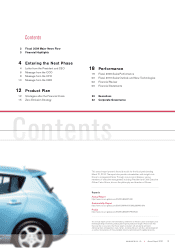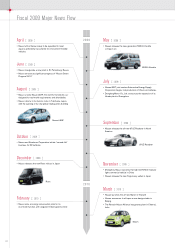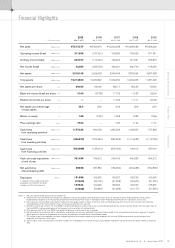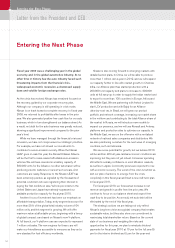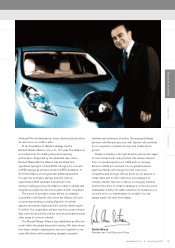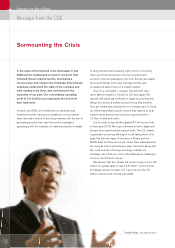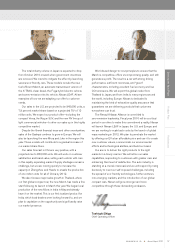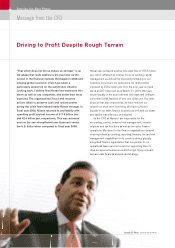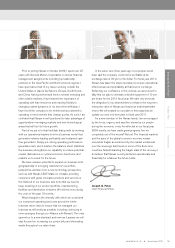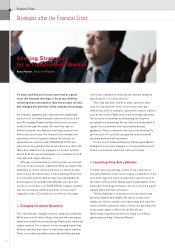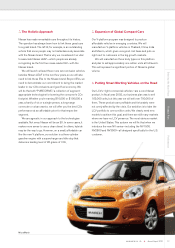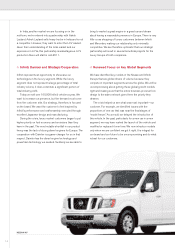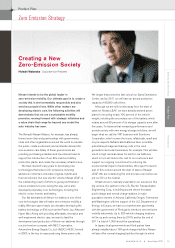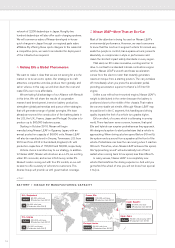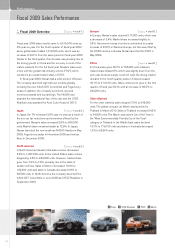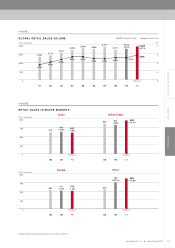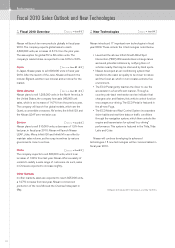Nissan 2010 Annual Report Download - page 13
Download and view the complete annual report
Please find page 13 of the 2010 Nissan annual report below. You can navigate through the pages in the report by either clicking on the pages listed below, or by using the keyword search tool below to find specific information within the annual report.
Entering the Next Phase Product Plan Performance
11Annual Report 2010NISSAN MOTOR CO., LTD.
Another assurance will be the return of a measure of
external stability. That includes having the total industry
volume in America—which dropped from 17 million units to
9 million, but is now approaching 12 million again—continue
to rise. Steady growth in key emerging markets such as
China and Russia will also contribute, as will the better
control of the debt that many countries accumulated during
the crisis.
In fiscal year 2010, we will continue to follow the
recovery plan, managing the cost base and dealing with
exchange rate fluctuations, higher raw material costs, and
the overall volatility in the various markets.
In the midterm, global economic activity will drive raw
material costs up. Therefore, our industry’s biggest
challenge is to take other costs out to allow consumers to
continue buying cars at the sticker prices they’ve become
accustomed to. We anticipate raw materials to continue to
rise. However, in addition to our monozukuri cost reduction
efforts, we will continue our frugal policy in expenses, such
as marketing, overtime, travel and G&A. We will eliminate
some unsustainable measures put in place during the crisis,
but we will adopt the new mindset related to all expenses,
based on our new standard. In other words, some of the
measures put in place throughout our company will become
the “new normal.”
Although conditions will continue to be harsh, we foresee
positive free cash flow, with operating profit of 350 billion
yen and net income of 150 billion yen for fiscal year 2010.
Capital expenditures will rise to 360 billion, but we expect to
return to a net cash position by the end of the fiscal year.
We will continue to run lean and prepare for better times in
2011.
Colin Dodge
Chief Recovery Officer
With things going well, some may question why Nissan
still needs a chief recovery officer. Market conditions are still
highly volatile. Six weeks into our business plan, for example,
the raw material assumptions we held two months ago are
irrelevant because prices for aluminum, platinum, copper
and flat steel have changed dramatically over the past
month. Fluctuating exchange rates have also had a massive
effect.
While markets have been volatile, we have been
effective. The recovery committee prepares
countermeasures and optimizes short-term performance.
While Nissan’s operating committee is strategic and our
executive committee even more so, we focus on what is
necessary at this time. For example, since demand is
fluctuating rapidly, we manage the allocation of vehicles to
countries by model to ensure that it is optimized. The
standard management mechanisms are not quick enough
for these uncertain times.
While our profitability is now among the top level in the
automotive industry and we have a strong balance sheet
with reduced net debt, Nissan is still in a crisis in that we
have not yet fully recovered. We’ve returned to profitability
from losses, but now we need to finish the job: get our COP
back to pre-crisis levels, net income after tax at top level,
and reduce our debt, so that we return to a net cash
position. Those are key milestones we will use to gauge
when the recovery is complete.
As always, the most crucial method of accomplishing all
that is to properly manage our cost base, mainly through
monozukuri costs and G&A expenses. Selling more vehicles
is another way and in fiscal year 2010, we plan to sell 3.8
million vehicles, which is a record total in the history of
Nissan.


